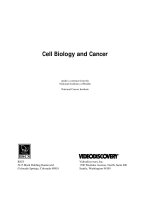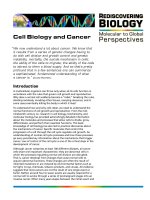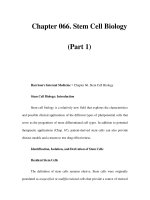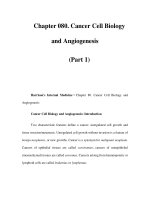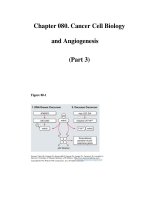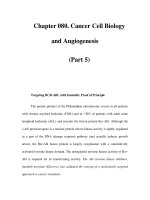Chapter 080. Cancer Cell Biology and Angiogenesis (Part 20) pdf
Bạn đang xem bản rút gọn của tài liệu. Xem và tải ngay bản đầy đủ của tài liệu tại đây (65.1 KB, 6 trang )
Chapter 080. Cancer Cell Biology
and Angiogenesis
(Part 20)
The bevacizumab experience suggests that inhibition of the VEGF pathway
will be most efficacious when combined with agents that directly target tumor
cells. This also appears to be the case in the development of small-molecule
inhibitors (SMI) that target VEGF receptor tyrosine kinase activity but are also
inhibitory to other kinases that are expressed by tumor cells and important for their
proliferation and survival. Sunitinib, FDA approved for the treatment of GIST (see
above and Table 80-2), has activity directed against mutant c-Kit receptors, but
also targets VEGFR and PDGFR, and has shown significant antitumor activity
against metastatic RCC, presumably on the basis of its antiantiogenic activity.
Similarly, sorafenib, originally developed as a Raf kinase inhibitor but with potent
activity against VEGF and PDGF receptors, increases progression-free survival in
RCC. Thus, agents that target both angiogenesis and tumor-specific signaling
pathways may have greater efficacy against a broad range of cancers. A caveat is
that RCC and GIST are highly dependent upon single signaling pathways (VEGF
and c-Kit, respectively) whereas most solid tumors use a panoply of
interconnected proliferation and survival pathways that are redundant and likely to
be less amenable to single-agent targeting.
The success in targeting tumor angiogenesis has led to enhanced
enthusiasm for the development of drugs that target other aspects of the
angiogenic process; some of these therapeutic approaches are outlined in Fig. 80-
11.
Figure 80-11
Knowledge of the molecular events governing tumor angiogenesis has
led to a number of therap
eutic strategies to block tumor blood vessel
formation.
The successful therapeutic targeting of VEGF is described in the text.
Other endothelial cell–
specific receptor tyrosine kinase pathways (e.g.,
angiopoietin/Tie2 and ephrin/EPH) are likely targets for
the future. Ligation of the
α
v
β
3
integrin is required for EC survival. Integrins are also required for EC
migration and are important regulators of matrix metalloproteinase (MMP)
activity, which modulates EC movement through the ECM as well as release of
bound growth factors. Targeting of integrins includes development of blocking
antibodies, small peptide inhibitors of integrin signaling, and arg-gly-asp-
containing peptides that prevent integrin:ECM binding. Peptides derived from
normal proteins by protea
lytic cleavage, including endostatin and tumstatin,
inhibit angiogenesis by mechanisms that include interfering with integrin function.
Signal transduction pathways that are dysregulated in tumor cells indirectly
regulate EC function. Inhibition of EGF-fam
ily receptors, whose signaling activity
is upregulated in a number of human cancers (e.g., breast, colon, and lung
cancers), results in downregulation of VEGF and IL-
8, while increasing
expression of the antiangiogenic protein thrombospondin-1. The Ras/MAP
K,
PI3K/Akt, and Src kinase pathways constitute important anti-
tumor targets that
also regulate the proliferation and survival of tumor-
derived EC. The discovery
that EC from normal tissues express tissue-
specific "vascular addressins" on their
cell surface suggests that targeting specific EC subsets may be possible.
Further Readings
Bild AH et al: Oncogenic pathway signatures in human cancers as a guide
to targeted therapies. Nature 439:353, 2006 [PMID: 16273092]
Dai Y, Grant S: Targeting multiple arm
s of the apoptotic regulatory
machinery. Cancer Res 67:2908, 2007 [PMID: 17409392]
Ferrara N, Kerbel RS: Angiogenesis as a therapeutic target. Nature
438:967, 2005 [PMID: 16355214]
Finkel T et al: The common biology of cancer and ageing. Nature 448:767
,
2007 [PMID: 17700693]
Huber MA et al: Molecular requirements for epithelial-
mesenchymal
transition during tumor progression. Curr Opin Cell Biol 17:548, 2005 [PMID:
16098727]
Kaelin Jr WG: The concept of synthetic lethality in the context of
anticancer therapy. Nat Rev Cancer 5:686, 2005
Panares RL, Garcia AA: Bevacizumab in the management of solid tumors.
Expert Rev Anticancer Ther 7:434, 2007
Sharma SV et al: Epidermal growth factor receptor mutations in lung
cancer. Nat Rev Cancer 7:169, 2007 [PMID: 17318210]
Sherbenou DW, Drucker BJ: Applying the discovery of the Philadelphia
chromosome. J Clin Invest 117:2068, 2007
Vousden KH, Lane DP: p53 in health and disease. Nat Rev Mol Cell Biol
8:275, 2007 [PMID: 17380161]
Bibliography
Jones PA, Ba
ylin SB: The epigenomics of cancer. Cell 128:683, 2007
[PMID: 17320506]
Michaloglou C et al: BRAF
E600
-associataed senescence-
like cell cycle arrest
of human naevi. Nature 436:720, 2005 [PMID: 16079850]
Soda M et al: Identification of the transforming EML4-ALK
fusion gene in
non-small-cell lung cancer. Nature 448:561, 2007 [PMID: 17625570]
Willet CG et al: Direct evidence that VEGF-
specifi antibody bevacizumab
has antivascular effects in human rectal cancer. Nat Med 10:145, 2004
